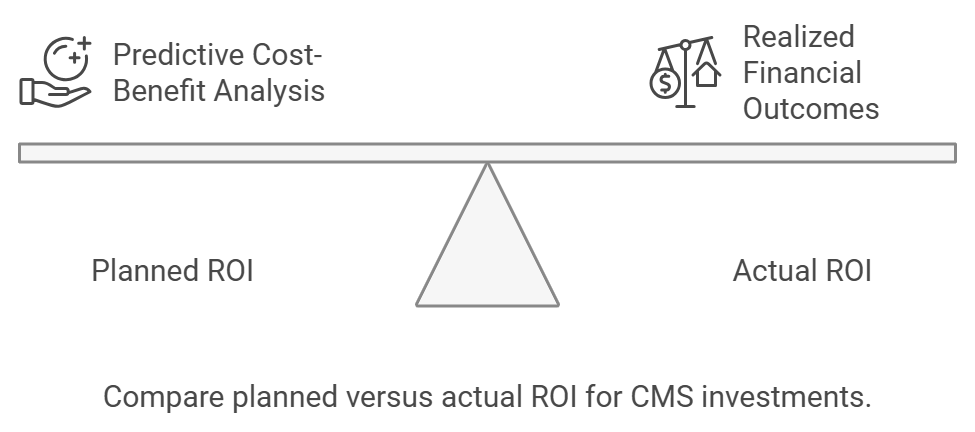Starting a CMS or content management system project is more than just a technological decision even though it may seem like that. But there’s more to it- it's about how to evaluate the ROI of Your CMS Investment!
Investing in a CMS project is a smart strategic move that can completely change the face of your digital operations. But how do we calculate the true value? What are the how’s of evaluating the ROI of your CMS investment?
To calculate and evaluate the ROI of your CMS investment is about striking the equilibrium between costs and benefits. It’s all about aligning your content management system with the business goals and optimizing workflows while also driving sustainable growth.
When evaluating CMS's ROI, the result is not solely financial—it has implications for efficiency, customer service, and competitiveness as well. Whether you’re choosing a new CMS, insisting on one, or evaluating an existing one, calculating its ROI is inevitable. Without proper evaluation, you risk underutilizing its potential, leaving revenue-generating opportunities on the table.
In this blog, we’ll pull back the curtain and show you the metrics, tactics, and tips you need to know to evaluate the ROI of your CMS investment. Drawing on years of experience to detail how your business can benefit from choosing a CMS, this article will examine how your CMS can help position your party status for growth in four fundamental areas: Operational Cost, Revenues, Usability, and User Experience.
So let’s get started to find the hidden value in your CMS platform.
Understanding the ROI of Your CMS Investment
While ROI or return on investment may seem like a simple topic, it is not! When evaluating the ROI of your CMS investment, what’s most important is the understanding of it as a broader concept.
ROI measures the profitability of an investment, providing a clear picture of whether your CMS is generating more value than it costs.
For businesses, ROI is a cornerstone metric that ensures every dollar spent aligns with strategic growth goals.
Planned vs. Actual ROI

The question- how to evaluate the ROI for your CMS investment can be viewed through two lenses: There is a significant difference between the planned ROI and actual ROI.
The anticipated or planned ROI is expected in advance of engaging or overhauling your CMS and is utilized as a predictive pointer to determine whether to proceed with it. It takes into account the probable costs), and the likely benefits and is useful in deciding on the risk-reward ratio.
However, actual ROI is evaluated after the implementation of a particular project of investment. It captures the real return derived or the cost and revenues incurred by the investment at the end. Actual ROI answers the critical question: how effective is your CMS?
Positive vs. Negative ROI

If the ROI for your CMS is positive you have achieved profitability of your CMS investment –your CMS has delivered more to your business than it has cost to implement and support.
On the other hand, negative ROI means that the costs are higher than the benefits within the system and indicates poorly aligned strategies, underutilization, or the potential of poor effectiveness.
Evaluate the ROI of Your CMS Investment: Why Does It Matter?
Companies use or plan to implement or migrate to other CMS platforms to increase productivity, and cutting on costs while supporting highly effective digital experiences. However, when implemented many organizations do not clearly outline the marketing and non-marketing gains thus losing prospects to assess performance progress.
By evaluating your CMS ROI, you can:
- Integrate technology into the business processes – Understand whether your CMS is fulfilling your organization’s purpose.
- See opportunities for improvement – Find out areas of weakness where certain processes or features could be slowing down.
- Increase output – increase productivity within your system while improving the service delivery to customers.
Challenges of Measuring CMS ROI
Some of the key challenges to evaluate the ROI of your CMS investment include:
Undefined Metrics of Success
One major issue that organizations fail to embrace is no clear notion of what success means. It is also important to define whether ROI should only encompass financial returns or figures such as satisfaction and customer loyalty rates.
Integration Complexities
A common challenge with many businesses is when they have implemented the CMS but cannot integrate it with other tools like CRM, marketing automation, or analytics. This hampers how much insight one can gain regarding the function of the CMS in business development.
Content and Workflow Bottlenecks
There appear some content and workflow bottlenecks during the implementation of the presented LMS. Sometimes, the company’s current CMS workflows are stale or the system itself is not well-designed and replenishment points can become clogged.
Inadequate Reporting Tools
Most importantly, the organization cannot track performance based on various touchpoints when the analytics and reporting tools are not very developed.
Key Metrics to Evaluate the ROI of your CMS Investment
To evaluate your CMS ROI effectively, focus on both tangible and intangible benefits:
1. Operational Efficiency
- Reduction in time spent on content creation, editing, and publishing.
- Automation of repetitive tasks (e.g., version control, translations).
- Improved collaboration across teams.
2. Revenue Generation
- Increase in conversions from CMS-powered digital channels.
- Enhanced lead generation through personalized content delivery.
- Higher customer lifetime value (CLV) due to improved user experiences.
3. Cost Savings
- Reduction in infrastructure costs through cloud-based or open-source CMS.
- Lower dependency on external developers for routine tasks.
- Streamlined processes reducing resource overheads.
4. User Experience Metrics
- Reduced bounce rates due to faster loading pages.
- Higher engagement with content.
- Improved accessibility for diverse user demographics.
How the ROI of Your CMS Investment Decreases Costs
A content management system (CMS) isn’t just a tool for enhancing user experiences—it’s also a powerful driver for cost reduction. According to the white paper Justifying Web Content Management: The Business Case and ROI by Gilbane.com, the highest ROI of your CMS investment often emerges when development and user training costs are significantly reduced. This is particularly evident when CMS platforms prioritize content-centric workflows over technical complexities, making implementation and scaling more seamless.
Several operational efficiencies contribute to evaluate the ROI of your CMS investment. For example, there are some tangible benefits like:

- Increased productivity through quicker task completion, such as content authoring, image resizing, and personalization.
- Reduced troubleshooting and support needs for content creators, allowing them to focus on value-driven activities.
- Time savings in training new users, fixing errors, and resolving system reliability issues.
- Lower maintenance demands, as robust CMS platforms ensure fewer technical problems and better vendor support.
Additionally, powerful CMS platforms can streamline web development tasks by automating or simplifying processes like:
- Designing and deploying web pages and templates.
- Integrating marketing tools and localizing content.
- Customizing and documenting web tools.
By shifting IT resources from routine tasks—like maintaining plugins or authoring content—to strategic projects, the ROI of your CMS investment grows. This realignment allows businesses to focus IT talent on innovation, driving organizational efficiency while maintaining a leaner operational structure.
Steps to Calculate CMS ROI

Step 1: Define Objectives
Outline the specific business objectives your CMS aims to achieve. Are you focusing on scaling operations, enhancing customer engagement, or boosting online sales?
Step 2: Track Investments
Document all associated costs, including licensing fees, implementation costs, training, and ongoing maintenance.
Step 3: Measure Benefits
Quantify both direct and indirect benefits. For example:
- Direct: Revenue generated from CMS-driven campaigns.
- Indirect: Time saved due to automation, leading to resource reallocation.
Step 4: Evaluate Over Time
CMS ROI is rarely immediate. Regularly assess its performance over 6-12 months to understand trends and long-term benefits.
The ROI Formula
Calculating ROI is straightforward, yet its insights are powerful:
For CMS projects, the formula adapts to reflect financial value derived from the system versus its cost:

By leveraging this formula, businesses can quantify the ROI of their CMS investment, ensuring data-driven decision-making and sustainable returns.
CMS ROI Best Practices: How Valuebound Can Help
At Valuebound, we specialize in helping businesses maximize the ROI of their CMS investments. Here’s how we address your challenges:

Tailored Solutions for Your Business Needs
We collaborate closely with your team to identify the pain points that hinder ROI. Whether it’s integration with existing tools or optimizing workflows, our experts ensure your CMS is aligned with your goals.
Analytics-Driven Insights
Our solutions include advanced reporting tools to track the performance of your CMS. From real-time analytics to in-depth audits, we empower you with data-driven insights.
End-to-End Support
From implementation to ongoing support, we provide a comprehensive suite of services to ensure your CMS investment continuously delivers value.
Case in Point: Success Stories
One of our clients, a global retail leader, experienced a 35% increase in online conversions after optimizing their CMS for faster load times and personalized content delivery. This was achieved through advanced integrations and automation, reducing manual content management efforts by 40%.
Is Your CMS Investment Working Hard Enough?
If you’re unsure about your CMS’s current ROI or are considering an upgrade, now is the time to act. Evaluating and optimizing your CMS is not just about numbers—it’s about ensuring your technology supports sustainable growth, customer satisfaction, and innovation.
Let’s Talk ROI
At Valuebound, we believe in turning CMS challenges into opportunities for growth. Contact us today for a free CMS ROI audit and discover how we can help you achieve more with your existing investments.
Explore the Full Potential of Your CMS
Download our exclusive ROI evaluation toolkit and take the first step toward transforming your CMS into a growth engine.
Subscribe to Our Newsletter
Get industry insights, expert tips, and actionable strategies delivered straight to your inbox.
FAQs
1. What is the ROI of a CMS investment, and why is it important?
The ROI of a CMS investment measures the financial value generated from your CMS compared to its cost. It’s important because it helps businesses understand whether their CMS is delivering value, optimizing resources, and aligning with strategic goals.
2. How can I calculate the ROI of my CMS investment?
You can calculate ROI using the formula:

This involves analyzing both tangible benefits, such as revenue growth, and intangible ones, like improved efficiency and customer satisfaction.
3. What factors influence the ROI of a CMS investment?
Key factors include:
- The platform's ability to reduce operational costs.
- Increased productivity from streamlined workflows.
- Enhanced user experiences leading to better engagement and conversions.
- The ease of integration with other tools and systems.
4. How can a CMS reduce operational costs?
A CMS can save costs by automating routine tasks, reducing the need for IT support, and improving system reliability. It also minimizes time spent on training, troubleshooting, and manual content creation.
5. When should I reassess the ROI of my CMS investment?
It’s ideal to reassess the ROI of your CMS 3-5 years after implementation or whenever your business goals, technology stack, or content strategy undergo significant changes. Regular evaluation ensures your CMS continues to deliver maximum value.



